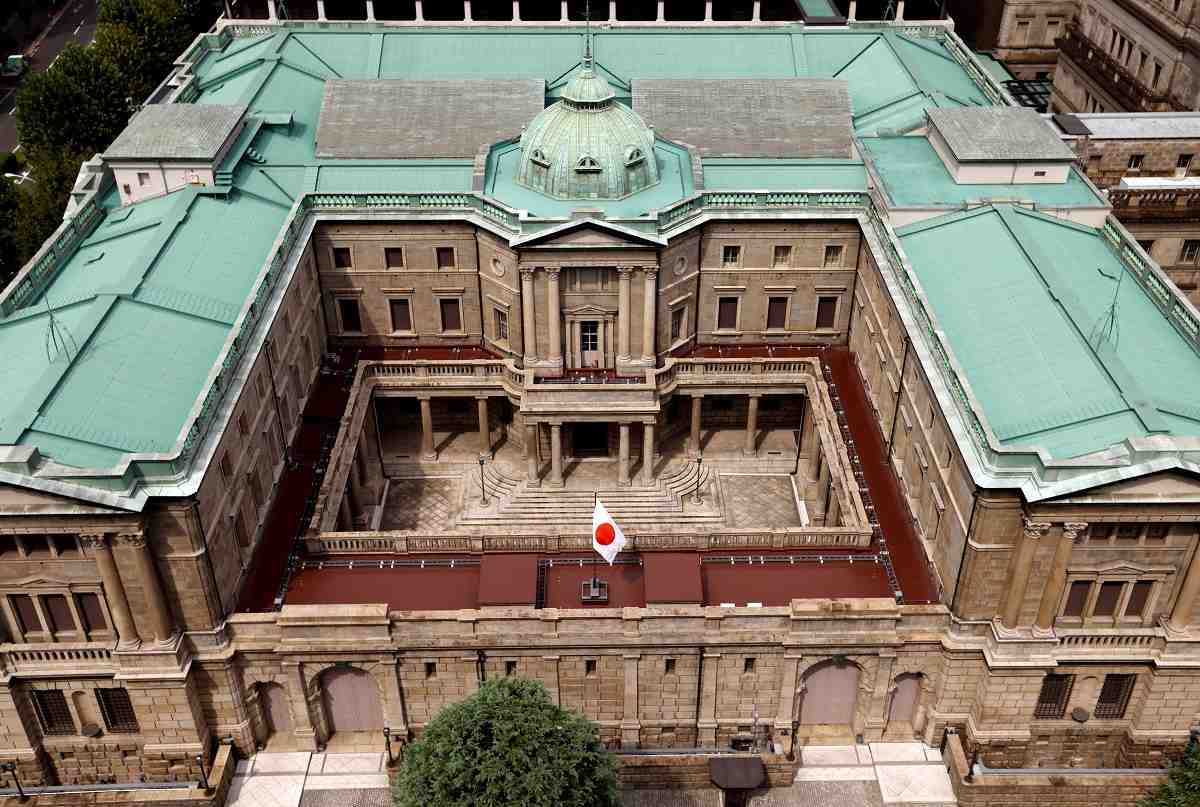
Japanese national flag is hoisted atop the headquarters of Bank of Japan in Tokyo, Japan September 20, 2023.
15:43 JST, December 19, 2023
SINGAPORE (Reuters) – The yen dipped and the Nikkei rose in relief on Tuesday after the Bank of Japan (BOJ) left its ultra-easy policy and outlook unchanged, while broader rallies for stocks and bonds in anticipation of U.S. rate cuts started to run out of puff.
The yen weakened about 80 pips to 143.41 per dollar following the decision, which was in line with economists’ forecasts. Technology shares led the Nikkei 1% higher. Japanese government bonds rallied a little. .TJP/
MSCI’s broadest index of Asia-Pacific shares outside Japan hovered just below a four-month high. S&P 500 futures ESc1 and European futures STXEc1 were flat.
The BOJ stuck to its short-term rate target of -0.1%, dovish forward guidance and 1% reference rate for 10-year government bond yields. Economists had expected no changes, but forecast rate rises by April – something governor Kazuo Ueda may choose to foreshadow at a news conference at 0630 GMT.
“The movement of a weaker yen is unlikely to become a trend, partly because expectations remain for a policy revision for January-March next year,” said Hirofumi Suzuki, chief FX strategist at SMBC in Tokyo.
Sumitomo Life Insurance economist Hiroaki Muto said he expects Ueda to play down prospects for swift shifts in his remarks: “He seems to be seeking a little more behind-the-curve normalization and (is) not as eager as the rushing market.”
Nippon Steel was the top loser on the Nikkei, falling more than 3% and touching a five-month low after the company announced a $14.9 billion deal to buy U.S. Steel X.N.
Elsewhere, oil held Monday’s gains on jitters around the safety of shipping through the Red Sea. Several countries have agreed to joint patrols to try to safeguard commercial routes after recent attacks on vessels by Yemen’s Houthi rebels.
Oil major BP and several big shipping firms say they are avoiding Red Sea transits for now. Brent crude futures LCOc1 were last up 17 cents at $78.12 a barrel. O/R
EQUITIES EYE HIGHS
Treasuries went sideways in Asia, nursing a small loss after Federal Reserve Bank of Cleveland President Loretta Mester and Chicago Fed President Austan Goolsbee each pushed back at market bets on swift U.S. rate cuts next year.
The 10-year U.S. Treasury yield US10YT=RR was down 1 basis point at 3.94%.
Equity markets had mostly shrugged off the remarks, with the Dow Jones .DJI and Nasdaq 100 .NDX marking record highs on Monday, while the S&P 500 .SPX drew nearer to the milestone. .N
Interest rate futures markets are pricing in more than 140 basis points of Fed cuts next year and were also unmoved by pushback last week from New York Fed President John Williams.
Aside from the yen, the Antipodean currencies made small gains, helped by yen selling and minutes showing Australian policymakers considered a second straight hike in December.
The Australian dollar AUD=D3 rose 0.2% to $0.6718. The New Zealand dollar NZD=D3 rose 0.3% to $0.6228.
The dovish outlook for U.S. rates had dragged the dollar index =USD down 1.3% last week, although similarly aggressive projections for rates in other major economies have kept a lid on further falls.
Markets imply around 150 basis points of easing by the European Central Bank next year, and 114 basis points of cuts from the Bank of England. 0#ECBWATCH, 0#BOEWATCH
That kept the euro EUR=EBS to $1.0921 and sterling GBP=D3 to $1.2662.
Bitcoin BTC=BTSP bounced from a one-week low to regain a footing above $42,000 on Tuesday. U.S. housing starts figures and Canadian inflation data are due later on Tuesday.
"News Services" POPULAR ARTICLE
-

American Playwright Jeremy O. Harris Arrested in Japan on Alleged Drug Smuggling
-

Japan’s Nikkei Stock Average as JGB Yields, Yen Rise on Rate-Hike Bets
-

Japan’s Nikkei Stock Average Licks Wounds after Selloff Sparked by BOJ Hike Bets (UPDATE 1)
-

Japanese Bond Yields Zoom, Stocks Slide as Rate Hike Looms
-

Japan’s Nikkei Stock Average Buoyed by Stable Yen; SoftBank’s Slide Caps Gains (UPDATE 1)
JN ACCESS RANKING
-

Keidanren Chairman Yoshinobu Tsutsui Visits Kashiwazaki-Kariwa Nuclear Power Plant; Inspects New Emergency Safety System
-

Imports of Rare Earths from China Facing Delays, May Be Caused by Deterioration of Japan-China Relations
-

University of Tokyo Professor Discusses Japanese Economic Security in Interview Ahead of Forum
-

Japan Pulls out of Vietnam Nuclear Project, Complicating Hanoi’s Power Plans
-

Govt Aims to Expand NISA Program Lineup, Abolish Age Restriction
























